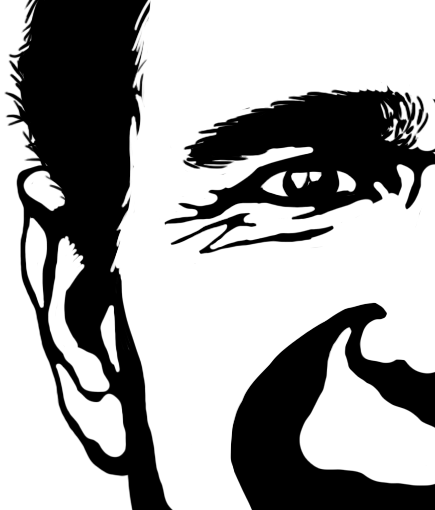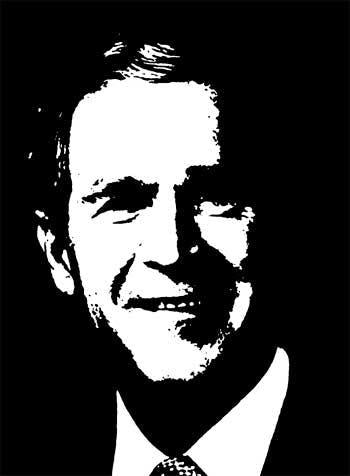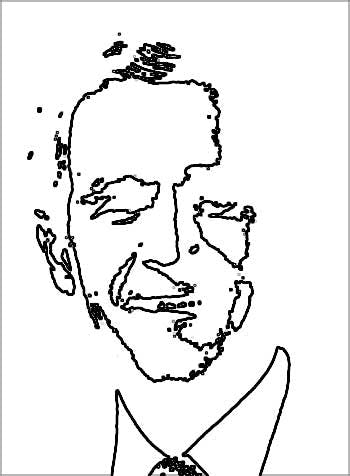How to achieve Likeness In A Portrait

In todays portrait-class I asked myself, what it is, that makes a drawing look like the person that you have drawn. What do you have to consider when you want to achieve resemblance, which factors are important? I did some experiments and found out some pretty interesting things.
It’s not about the proportion
Just look at the picture to the right. Can you recognize this person? I drew exactly over a photo of him, so the proportion should be quite correct.
Nevertheless it’s not that easy to realize who this person is supposed to be. In fact, this portrait sucks pretty much even if the proportions are correct.
Besides caricatures wouldn’t work, if the proportions where that important for recognizing a face.
For example look at the great paintings of Sebastian Krüger. In most of his caricatures the proportions are completely displaced but you still won’t have any problem to identify the persons caricatured.
It seems like the relation between the size and distance of parts of the face are not that important for the recognition value of a face.

Creating Likeness in a Portrait
Now take a look at this picture. This time it should be quite easy to identify the person.
Is is because we can see more of the detail?
No. Even if you squint your eyes, making your view blurred you will still be able to recognize the person.
So it must have something to do with the light!
Yes and no. It’s not the light itself. If you could recognize a person because of the light, it would depend on the lightning, if you are able to identify someone or not. But you can identify a face you know under nearly every lightning condition.
But the light shows you something else. Something we didn’t saw in the first line-drawing. It shows you the 3-dimensional volume of the face.
Everyone is able to identify someone from nearly every angle. Our brains seem to recognizes faces independently from the perspective in which we are seeing it. Our brains don’t remembers certain outlines, they remember the 3-dimensional form and the volume.
Edges, corners, dints, furrows, coves, convex- and concavities. The ups and downs of a (sur-)face, how it arches and dips. All this characterizes a form. In case of a face this is what creates its likeness.
This is why it is so hard to recognize the person from the shitty line-drawing above, which just shows outlines, but gives only a few clues about the 3-dimensional form itself.
But drawing lines along the shadow borders just don’t mean you are doing a good portrait.
This picture shows the outline of the black & white picutre above.
Though the lines are running exactly along the shadow borders of the above picture, the likeness is completely destroyed. This kind of drawing just don’t make sense to our brain.


How to line-draw a portrait
The line-drawing above shows you why computers can’t do art. A good drawing is neither made by just following the major outlines of a face, nor by following a shadow border.
Neither do you have to draw every single change of direction in the face nor can you just draw lines around the eyes, mouth and nose. You have to find the big and the important shapes and forms and you have to find lines to describe them 2-dimensional.
But don’t think 2-dimensional. Try to imagine how the lines are running into the room, try to push them into the space.
Eyes or mouth are often drawn just as flat forms, but they got a volume that is important for their recognition, so you have to draw it. If the eyes of your drawing don’t look like the ones from your model, you probably just didn’t capture their subtle form and shape or gave no attention to their volume.
That’s also why it’s so difficult to draw from a photo. You tend to draw just 2-dimensional shapes, ignoring the 3-dimensional form of the object. But you have to paint the volume.
The more you are able to draw the volume instead of just flat shapes, the more you will notice, that your drawings will come to life, get more personality and will be easier recognized.
Trying to rescue a drawing by shading it fails most of the time. This is because if your lines don’t capture the form correctly, a shading won’t undo this mistake. So try to draw a face and only if the drawing works start shading it.
How to draw a person from a photo
Don’t try to draw from just one photos. Try to get as much photo as possible of the person you are going to draw. The more references you have, the better you can try to understand the 3-dimensional form of the face.
Try to imagine the head in 3 dimensions while drawing. Don’t just copy a photo.
A last hint for caricatures
Try to exaggerate the 3-dimensional forms instead of 2-dimensional shapes. This will make your caricatures look much more realistic and increase the likeness of them.
A little bit about me
My name ist Marcus Blättermann.
I’m majoring in communication design and work as a freelancer for illustration, print- & webdesign.
What you should do next
Don’t forget to follow me on Twitter. You should also check out my Portfolio.